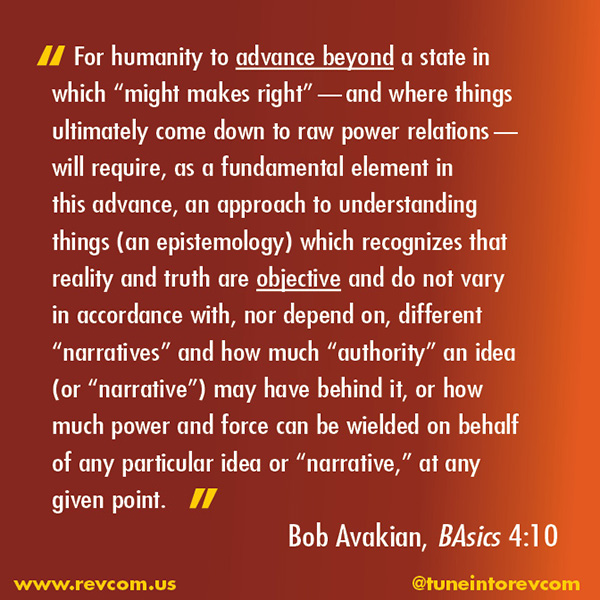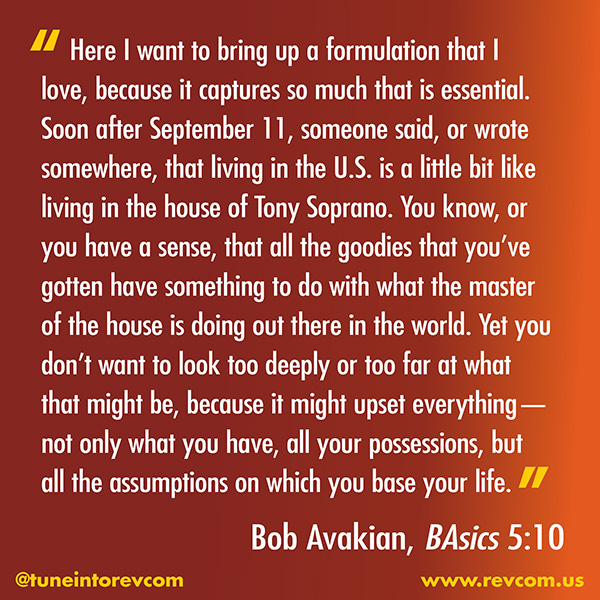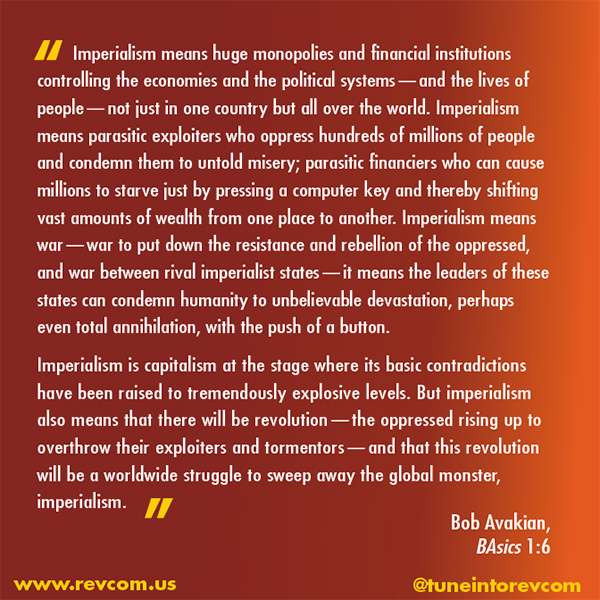The Nostalgia for George H. W. Bush and the Dream of a Kinder, Gentler Imperialism
| Revolution Newspaper | revcom.us
In the week just past, the treatment of the death of George H. W. Bush called forth the hope of a “kinder, gentler America.” But do the facts back up those hopes?
Let’s start with this: In 1988, an Iranian commercial airliner, flying its normal route in Iranian airspace, was shot down by a U.S. Navy ship, illegally operating in Iranian waters. Two hundred ninety people, including 66 children, were killed. And what was then-Vice President Bush’s reaction? “I will never apologize for the United States—I don't care what the facts are. [Emphasis added]”
If you’re the leader of a country where the facts are that it enslaved tens of millions of African people for centuries… that it committed genocide against millions of Native Americans and then stole the lands of the rest… that it dropped the only two nuclear weapons that have ever been dropped, on two Japanese cities with no military installations... and then went on to kill millions in Korea in the 1950s and millions more in Vietnam in the ’60s and ’70s, along with other crimes too numerous to mention… all to ensure that the rulers of this country could exploit and plunder whoever and whatever they could get their hands on… then it probably makes sense to never apologize and to ignore, cover over, or just not care what the facts are.
But if you really want a better world, you do have to look at the facts.
“Kinder and Gentler”?
Leaving aside his stint as head of the CIA in 1976, Bush came to the top levels of national power in 1980 as vice-president, and then ruled as President from 1989 to 1993. Though, we could fill a whole edition of revcom.us with crimes of U.S. Imperialism that George Herbert Walker Bush participated in his years working with CIA, and briefly as head of the CIA, and in the many positions he held as a “diplomat” in close proximity to brutal efforts to suppress people around the world.
In 1989, shortly after coming to office, Bush launched war against Panama. The de facto leader of Panama, Manuel Noriega, had been someone who worked with the CIA but then ran afoul of the U.S. when he was rumored to have become a double agent for Cuba. After Noriega annulled an election in Panama, Bush sent more American troops to guard the U.S.-owned canal there. When an off-duty U.S. Marine was killed, Bush launched an invasion! This invasion included wholesale massacres in El Chorrillo, a poor neighborhood where support for Panamanian President Noriega ran high. U.S. air power pulverized El Chorrillo from the air until it looked like “Little Hiroshima”; then U.S. troops moved through burning building by building, shooting the inhabitants in the streets, piling the dead and wounded together in heaps. At least hundreds of civilians, perhaps more, were killed in El Chorillo alone.
Flush with that “victory,” Bush went on to wage the first Gulf War against Iraq in 1990-91. Iraq had occupied Kuwait after what was at least an ambiguous signal from the U.S. Ambassador that it would not be opposed if it did so. Bush moved to marshal an international fighting force against Iraq in part on the basis of a campaign of outright lies about Iraqi troops having ripped babies from incubators in Kuwait and an imminent Iraqi invasion of Saudi Arabia. Quickly routing the vastly out-armed Iraqi forces, the U.S. used overwhelming air power to rain death on a retreating caravan of Iraqi soldiers, many of whom had abandoned their military vehicles, as well as on Kuwaiti civilians. At least 25,000 retreating Iraqi soldiers were slaughtered, many on what became known as The Highway of Death. The White House declared the dead to be “torturers, looters, and rapists.” During the war, the U.S. Air Force deliberately devastated Iraq’s civilian infrastructure (water purification plants, flour mills, power plants), leading to malnutrition and outbreaks of cholera and typhoid. One Census Bureau demographer estimated that by January 1992 some 70,000 Iraqi civilians had died due mainly to the destruction of water and power plants.1
And yes, Bush did, as vice president under Reagan, and then as President, play a major role in formulating a full-court press against its main imperialist rival in the world, the Soviet Union, which—along with a severe internal crisis—led to its collapse and the reintegration of much of its bloc into the U.S. empire. But this did NOT happen “without a shot” as Barack and Michelle Obama claimed in a formal statement on Bush’s death, but through a decades-long bloody campaign of coups, interventions and regional wars against Soviet interests on several continents—wars in which at least hundreds of thousands of civilians were killed and countries and regions like Central America, Afghanistan, and southern Africa were driven from the “regular” grinding oppression under imperialist thumbs into a straight-up nightmarish existence of war and ruin. All this took place in the context of and was set against a backdrop of a massive U.S. nuclear buildup that at different points brought the world to the brink of possible nuclear annihilation. (For example, see these articles in the revcom.us “American Crime” series: “Operation Condor 1968-1980s: U.S.-Directed Campaign of Political Assassination and State Terror in Latin America”; “The 1973 CIA Coup In Chile.”)
“Thousand Points of…” What?
Bush was eulogized for trying to bring light to America, and for refusing to demonize whole sections of people, as Trump does.
Again, though, what are the facts?
Bush became president in 1988 after one of the dirtiest campaigns of those times, against the Democrat Michael Dukakis. There were slanders and lies, but the most notorious was the Willie Horton ad. This ad featured a Black prisoner who, while on furlough in Massachusetts, raped a white woman. While not “officially” sponsored by the campaign, Bush’s campaign manager and protégé, Lee Atwater, had bragged that he was going to make America think that Willie Horton was Dukakis’s running mate. The ad helped get Bush elected, but more fundamentally it served the ruling class program of demonizing Black people at a time when the system was furiously heightening the mass incarceration of Black, and Latino, masses.
Bush continued the War on Drugs, which during the Reagan administration included not just vicious criminalization and repression rained down against Black and Latino people, but the continued pumping of drugs into the ghettos and barrios (including during his vice-presidency with, at minimum, the cooperation of high-ranking members of the Reagan Administration). During Bush’s time in office, as vice-president and then president, the federal prisoner population nearly tripled—with 60 percent Black or Latino. The sheer amount of suffering embodied in this simple recital of facts hurts the mind to contemplate.
Much has been made of Bush’s vote for the Open Housing Act of 1968, which probably did cost him re-election to the House that year. And some have said that Bush regretted the Willie Horton ad. But the fact that Bush did not traffic in the most openly retrograde white supremacy as his regular public image (in distinction from people like Reagan or Trump) and even opposed it on occasion early in his career, and may to some extent have personally regretted the times he did, only underlines his willingness to use, legitimize, and reinforce the most vile white racism when he thought the chips were down and it would serve not just his career but even more the needs of the system which relies on that racism as an integral element of its social order.
In the early 1980s, when a section of the ruling class brought forward the Christian fascists as a major political force, Bush set aside whatever personal “social liberalism” he was said to have had in order to promote what he understood to be “larger” imperialist interests. Bush’s administration opposed federal funding for abortion and unsuccessfully urged the Supreme Court to overturn the Roe v. Wade decision that legalized abortion.2 And, he nominated and pushed through the appointment of Christian fascist Clarence Thomas—widely considered the most reactionary Justice on the Supreme Court.
Bush became president as the HIV/AIDS epidemic grew to massive scale—59,000 Americans, mainly gay men—had already died. But Bush was, according to LGBT activists, “absent” or “actively hostile” to the effort to find a cure, and he “utterly ignored” even the recommendations of his own National Commission on AIDS. Instead, Bush argued that AIDS was “a disease where you can control its spread by your own personal behavior” (and for the Bush administration, this did not mean education in safer sex, but total abstinence).
Nostalgia for the Norms
Bush was eulogized for not just respecting but befriending and even taking under his wing ruling class opponents like Bill Clinton, who defeated him. Bush left Clinton a world in which the U.S. seemed to be riding high, finally unchallenged. In fact, even as Bush was stepping down, deep centrifugal forces within U.S. society were being exacerbated, and new international challenges to U.S. dominance began to arise. These would find expression in extremely sharp contradictions between different blocs of the ruling class. The dynamics of how that unfolded and what brought it into being are beyond the scope of this piece, but we urge you to go to Bob Avakian’s “The Truth About Right-Wing Conspiracy… And Why Clinton and the Democrats Are No Answer” to read what was a deep-going and highly prescient analysis. The point here is that the respect that Bush (generally) extended to his ruling class opponents did NOT extend to those whom the empire he headed exploited and oppressed; and the same holds true for those ex-presidents who mourned him.
There is no kinder, gentler imperialism; there are no thousand points of light under capitalism. And whether those who eulogize Bush care or not, those are the facts.
1. Oil, Power & Empire: Iraq and the U.S. Global Agenda, p.155, citing Philadelphia Inquirer, January 5, 2003. [back]
2. All Things Considered, December 8, 2018. [back]


On December 20, 1989, the U.S. military invaded Panama with 27,500 troops and 300 aircraft, killing thousands of civilians and removing Manuel Noriega. Photo: AP


Get a free email subscription to revcom.us:

